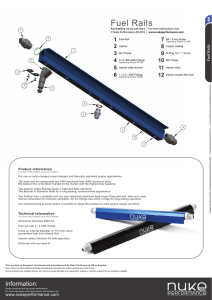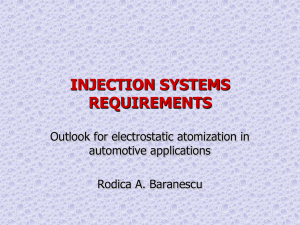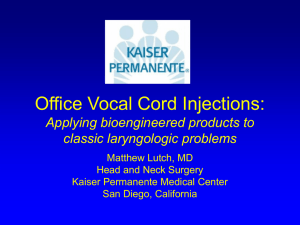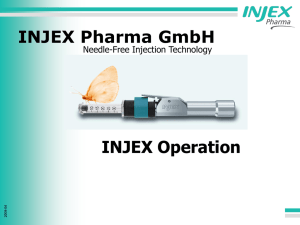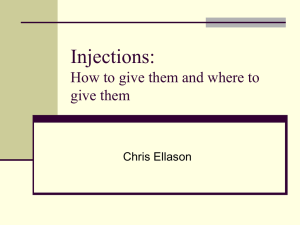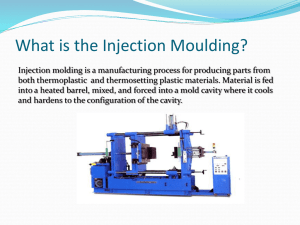Lecture 21
advertisement
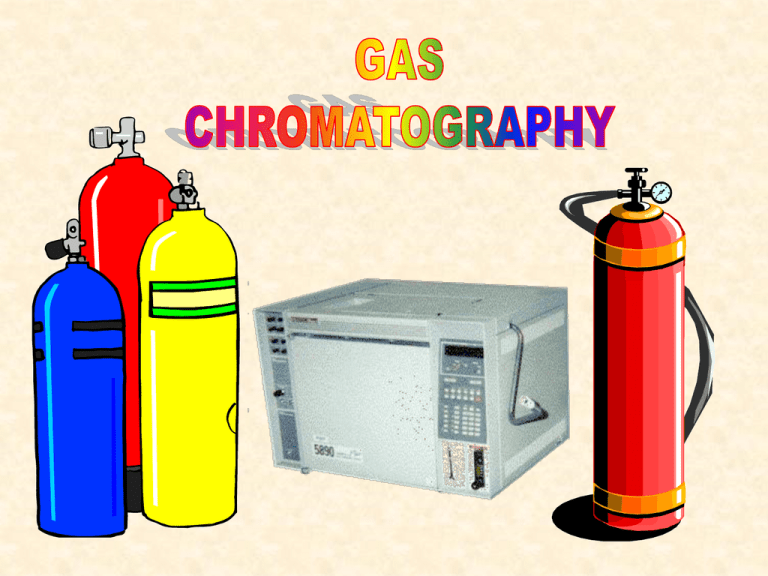
Gas Chromatography Injector Port Flow Control Detector Recorder Recorder Column Column Oven Carrier Gas The GC system consists of gas supplies for the mobile phase (and the detector, if needed), flow controls for the gasses, an injector, an oven for heating the column, a detector, and a data recording device. Sample Preparation 1. 2. 3. 4. Direct Injection of Gasses Dynamic Headspace SPME (Solid Phase Microextraction) As a Liquid Via a Syringe Direct Injection of Gasses Gasses can be sampled with a simple gas-tight syringe and introduced directly into the GC injector. Another method of direct injection of gasses, uses a sample loop similar to the ones used in HPLC. The sample loop is filled with the gas sample and the valve is turned to divert the sample to the GC column. Direct Injection of Gasses Unlike HPLC, temperature and pressure must be carefully controlled because the mass of the sample will depend on these factors as gasses expand and contract depending on the temperature. Cryofocusing: Larger volumes of gasses can be introduced into a specialized injector where the analytes are focused on a cold surface and then volatilized by rapid heating. Dynamic Headspace While direct injection of gasses can be used, many volatile analytes are often in too low of a concentration to be quantified using most common detectors. For this reason, volatiles in the headspace are often concentrated using dynamic headspace or purge-and-trap methods. Dynamic Headspace Typically the sample is placed in a closed container and a flow of inert gas such as nitrogen is used to purge the headspace onto an adsorbent or a cryogenic trap. Cryogenic traps are more complex than adsorbent traps but they are the least selective and will contain virtually any aroma compound in the sample. However, cryogenic traps will also concentrate water (the most abundant volatile in food), and the aqueous sample must be further processed. Dynamic Headspace Common adsorbents, do not trap much water, and the traps can be thermally desorbed directly into the injector of a gas chromatograph. Tenax is one of the most common trapping materials because its high thermal stability makes it the best choice for thermal desorption. Dynamic Headspace T able 1. P hysica l P ro perties o f S o m e A dso rba nts U sed fo r P reco nce ntratio n o f O rga nic V o lat iles fro m the V apo r P hase. o C o m po und S urfac e area M ean po re D ia.(Å ) T e m peratureL im it( C ) 2 (m /g) T ena x G C 19-30 720 450 C hro m o so rb 102 300-400 90 250 C hro m o so rb 105 600-700 500 200 P orapak Q 630-840 75 250 X A D -4 750 50 200 X A D -7 458 80 150 S o urce. S ucan et al. (1). Solid Phase Microextraction Sampling devices (manual and autosampler) consist of a coated silica fiber inside a hollow needle. The coating on the fiber adsorbs and concentrates volatiles from the headspace inside the sample container. The needle protects the fiber which can be inserted through the septa of the GC injector for direct analysis. Some Common Fiber Coatings Used with SPME C o ating M ateria l U ses T ype PDM S N o npo lar se m ivo lat iles (M W 60-275) A bso rbent, N o npo lar P o lyacrylate P o lar se m ivo lat ile s (M W 80-300) A bso rbent, P o lar P D M S /C arbo xe n T race-le ve l vo lat iles (M W 30-225) A d so rbent, B ipo lar P D M S /D V B V o lat iles, nitro gen co m po unds (M W 50-300) A d so rbent, B ipo lar C W /D V B A lco ho ls and po lar co m po unds (M W 40-275) A d so rbent, P o lar D V B /C arb./P D M S V o lat iles a nd se m ivo lat iles (M W 40-275) A d so rbent, B ipo lar P D M S = Po lyd im ethylsilo xa ne, D V B = D ivinylbe nze ne, C W = C arbo w a x Quantification of Analytes with SPME External calibration curves can only be used if the standards are made up in the same matrix as the test sample. For complex samples such as foods, internal calibrations such as isotopic dilution or standard addition should be used. Care must be taken to ensure that the response is linear in the concentration range of the sample and the spiked sample, and multiple standard addition is advised whenever practical. Percent Change in Peak Area Due to the Addition of Salt C o m po und 15% N aC l E tha no l 38 Z -3-H exa no l 220 H exyl A lco ho l 200 E thyl B ut yrate 170 L ina lo o l 300 L im o ne ne 25 -37 -P ine ne S o urce. Steffe n and P aw lisz yn (6). 36% N aC l 94 1000 700 920 2170 32 -26 42% N aC l 150 1040 4200 880 2230 -25 -49 Injection of Liquid Samples in Gas Chromatography Much more difficult than you would think! The most common method of introducing a sample into the GC is with a microliter syringe, hence this process has become known as injection. Syringe Loading Methods Hot Needle Injection Can help reduce bias in the injection of complex samples Pull the sample up into the barrel of the syringe and then pre-heat the needle for several seconds before injecting. This reduces the condensation of high boiling point compounds on the walls of the needle. Split/Splitless Injectors ...are probably the most common types Splitless Injection, (where the split vent is closed) attempts to transfer all of the sample to the column and is used for trace analysis. Split Mode, only a small portion (maybe 1-10% of the sample moves into the column, and the rest is sent to waste. This is used when the analytes are in high concentration and would overload the column. How a Split/Splitless Injector Works Backflash When a liquid solvent is transferred into the hot injector, it vaporizes and expands. If the injector volume is not large enough to contain the expansion, a problem called backflash can occur. The sample expands so much that it can reach to the septum purge area and part of the sample can be lost through the septum purge. The sample may also condense on the cooler area of the upper injector, and may re-volatilize slowly. Backflash can result in poor peak area reproducibility, solvent peak tailing, ghost peaks or non-linear increases in peak area as injection volume increases. Determining Liquid Volumes for Injection Table 4. Liner Volumes Theoretical 1.0 mm ID 59 mL 2.0 mm ID 236 mL 3.0 mm ID 530 mL 4.0 mm ID 942mL Effective 30 mL 118 mL 265 mL 471 mL Solvent Expansion Volumes o T able 5. So lve nt E xpansio n V o lu m es( injecto r 250 C and 10 psig) 0.5 m L H 2O 710* E xpa nsio n V o lu m e s m L (vapo rized) CS2 C H 2 C l2 H exa ne 212 200 98 Isoo ctane 78 1.0 m L 1420* 423 401 195 155 2.0 m L 2840* 846* 802* 390 310 5.0 m L 7100* 2120* 2000* 975* 775* In jection volum e (Liquid) Ways to Reduce Backflash 1. Optimize sleeve Pack with glass wool or use double gooseneck 2. Inject less 3. Decrease injector temperature 4. Increase head pressure (higher flow rate into column) Cool On-Column Injection This method places the liquid sample directly on a cooled column. and then the column inlet is rapidly heated to vaporize the sample. Advantages: highly reproducible minimal molecular weight discrimination backflash is not a problem minimal thermal degradation Disadvantages: difficult to handle the small needles required solvent overload (peak splitting) contamination with non-volatiles Temperature Programmable Injector Temperature programmable injectors are a combination of split/splitless injectors and cool on-column inlets. Advantages: more flexibility than on-column injection better than on-column injection for dirty samples can concentrate sample using solvent purge mode Disadvantages: cost complexity

